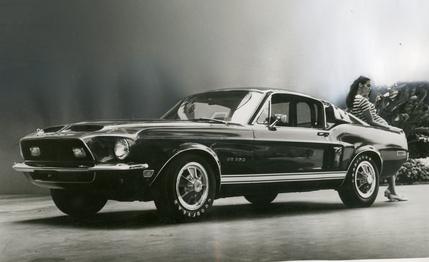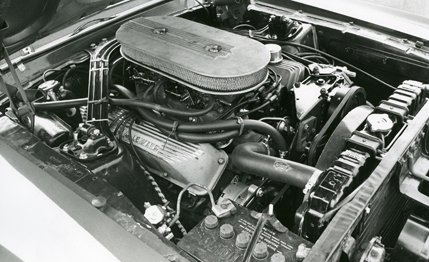
 Archived Road Test
Archived Road Test


Seven liters! Four hundred and twenty-eight cubic inches in a Mustang! We were expecting a cataclysm on wheels, the automotive equivalent of the end of the earth. We were pleasantly surprised to discover that the GT 500 isn’t anything like that.
The old corollary to that old adage, “There’s no substitute for cubic inches,” is “except rectangular money”–and who would know better than Carroll Shelby. When the Cobra 289 peaked out on the racetrack, there were several ways of making it go faster–most expensive, one cheap. One of the more expensive ways was the Daytona coupe body. The late Ken Miles found a better way. At Sebring in 1964, he shoehorned a Ford 427 NASCARized engine into a Cobra roadster. The experiment came to rest, sorely bent, against a palm tree, but Miles persisted. By the end of the season, at Nassau, he had another one bolted together. It blew up, but the die was cast. Early in 1965, Shelby announced the Cobra II with a 427 cu. in. V-8 replacing the 289. That June, at Le Mans, two of Ford’s rear-engined GT prototypes appeared with the big 427 instead of the 289. The Europeans hooted and jeered at the bulky, heavy, unsophisticated V-8 with its pushrods and single four-barrel carburetor. A year later, Ford 427s swept the first three places at the French classic, with Shelby’s two entries dead-heating the final lap. What the 427s had beaten was a team of 270 cu. in. Ferrari V-12s with multiple carburetion and four overhead camshafts. The Italian engine developed almost as much horsepower as the Ford–425 hp vs. 485–but it was much more tautly stressed and, therefore, fragile. Which is the whole point of 7-liter Fords, Cobras, and now, Shelby Mustangs.
For '67, Ford offered the Mustang with their tried-and-true 390 V-8, which has a bore and stroke of 4.05 x 3. 78 inches. Ford also builds a 428 V-8 on the same block with a bore and stroke of 4.13 x 3.98 inches. Why not, reasoned Shelby, use this engine in the '67 Shelby Mustang? Why not indeed. The car is called the GT 500 and its engine is called the Cobra Le Mans.


Somebody is telling a little white half-truth.
Please note that the Cobra Le Mans engine displaces 428 cubic inches. That sounds like a hair better than the 427. In fact, they are two entirely different engines. Both have the same external dimensions, but the 427 is more oversquare, with a bore and stroke of 4.23 x 3. 78. The 427 is a racing engine, full of the kind of intestinal fortitude that makes it capable of enduring 500 miles at Daytona and 24 hours at Le Mans. The 428 is a passenger-car engine, and nearly $1000 cheaper than the 427. Few people would be happy with the 427 unless they were racing it. It’s noisy, balky, and an oil burner at normal highway speeds.
The GT 500 is not a racing car, although but for a few subtle differences its engine is the same as the one that propelled Shelby’s Fords to victory at Le Mans. Seven liters in a Mustang! The early GT 500 engineering prototype was the fastest car ever to lap Ford’s twisty handling loop, except for the GT 40s, of course. And the same car cut a quarter-mile in 13.6 seconds at 106 mph. Super car!